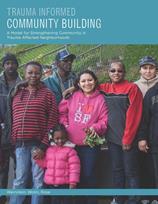 SAN FRANCISCO, CA, June 27, 2014—A white paper published by BRIDGE Housing and San Francisco State University presents a new model for strengthening high-poverty, challenged communities as part of housing transformation efforts.
SAN FRANCISCO, CA, June 27, 2014—A white paper published by BRIDGE Housing and San Francisco State University presents a new model for strengthening high-poverty, challenged communities as part of housing transformation efforts.Titled “Trauma Informed Community Building” (TICB), the paper documents strategies that de-escalate chaos and stress, build social cohesion and foster community resiliency over time.
The TICB model is based on five years of BRIDGE Housing’s community building work at the Potrero Terrace and Annex public housing site in San Francisco. The Potrero development is part of San Francisco’s HOPE-SF initiative to rebuild some of the most distressed public housing in the city.
At the Potrero site—as at many other public housing sites across the nation—cumulative trauma results from daily stressors such as concentrated poverty, chronic health and mental health conditions, violence, low levels of education, and structural racism and isolation. The TICB approach takes into account residents’ emotional needs and avoids re-traumatization triggers, which “traditional” models of community building may ignore or exacerbate.
The four underlying principles of the TICB model are:
Principle 1: Do No Harm
Be aware of past and current trauma and promote activities, programs and services that avoid re-traumatizing individuals and the community. Acknowledge that traumatized communities face ongoing insecurities around the sustainability of programs, services and institutional relationships, so only engage in activities when financial sustainability and organizational structure are guaranteed for multiple years.
Principle 2: Acceptance
Meet residents where they are, accept the realities of the community conditions and set expectations accordingly.
Principle 3: Community Empowerment
Recognize the importance of self-determination to encourage community investment and that everyone can play a supportive role. Peer support promotes a sense of hope and control, and validates individuals’ actions as having meaning and value, which is necessary for visioning for the future and actualization of plans.
Principle 4: Reflective Process
Take a sustained approach over multiple generations to improve outcomes in a trauma impacted community. TICB engages in an ongoing reflective practice that responds to new developments and knowledge, and is constantly adjusting to meet the needs of the community and the overall vision for the neighborhood.
At Potrero, those principles have been put into action through a host of activities tailored to serve the needs of residents; examples include a weekly dinner and reading group for parents and children, a robust garden program, twice weekly Zumba classes, a sober living group and leadership academies.
“We know that it is not enough to just rebuild the housing,” said Cynthia A. Parker, President and CEO of BRIDGE. “TICB increases the capacity of residents to improve their quality of life and effect positive change at the individual, interpersonal and community levels. Ultimately, the goals is to pave the way for the effective delivery of services and provide the foundation for a healthy, sustainable and thriving neighborhood.”
To download a free copy of “Trauma Informed Community Building: A Model for Strengthening Community in Trauma Affected Neighborhoods,” visit bridgehousing.com. The paper was written by Emily Weinstein, MCP, MSRED, Director, Potrero Community and Housing Development, BRIDGE Housing Corporation; Jessica Wolin, MPH, MCRP, Associate Director for Community Practice, Health Equity Institute, Clinical Faculty, Department of Health Education, San Francisco State University; and Sharon Rose, MPH, Writing Consultant.
For more information about BRIDGE’s work at Potrero Terrace and Annex, visit www.rebuildpotrero.com.
###